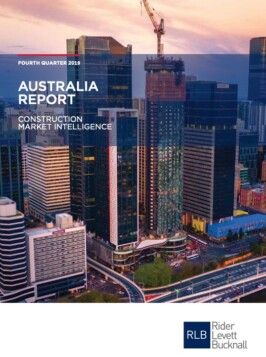According to the Rider Levett Bucknall (RLB) 4th Quarter 2019 Australia Report, construction cost growth is forecast for all cities in 2020.
Domenic Schiafone, RLB Director of Research and Development said, ‘Escalation forecasts experienced across the country for 2019 showed similar levels to 2018. EBA wage growth is being offset by falling construction volumes. Even with most cities reporting increasing pressure on obtaining skilled labour for many trades, the limited coverage is currently not impacting total tender pricing.’
Into 2020, construction pricing is expected to rise in most regions – with Canberra, Melbourne and Sydney showing small falls due to a slowing forecasted activity. Stronger activity in Perth and Darwin is seeing higher levels than those experienced after the mining construction boom. Adelaide is forecast to have the highest escalation rate across the country from 2021, highlighting the forecasted growth in state and federal spending together with some significant private sector projects.
Influence of global economy greater than ever
The growing urbanisation of Asia and the rising living standards in both China and India have had a significant impact on the growth of exports. Current economic surveys within Australia are reporting sharp declines in expected growth including the construction sector over the next twelve months, together with more rate cuts by the reserve bank – generally not a sign of a robust economy.
Domenic continued, ‘The past decade has seen significant volumes of construction work being undertaken around the country with record levels of dwellings completed, adding much needed stock for the growing population. Associated roads, social infrastructure and commercial development is following this housing surge backed by significant inputs by federal and state governments.’
He added, ‘We are now however in the midst of slowing segments of the construction industry. The tightening of finance, changes to planning requirements in the larger cities and reduction in foreign investment, are all having an impact on both the commercial and residential sectors.’
Consumer confidence impacts new apartment projects
Falling consumer confidence due to the cladding and structure issues within the residential multi-storey market is impacting on the commencement of new apartment projects. Recent government initiatives such as the $600m cladding initiative from Victoria and the appointment of a Building Commissioner in NSW will give some much needed confidence to the market if both initiatives produce results in a timely manner.
According to the latest ABS results, construction work done fell by 6.4% for the 12 months ending June 2019. In nominal terms this was 36.8% above 2010 numbers.
Even with the slight fall, the industry achieved construction work done of $217 billion for the 12 months to March 2019, which is 8% above the decade average of $204 billion. Currently a workforce of almost 1.2 million is employed to deliver the current volume of work done.
Construction workforce to fall
As infrastructure projects ramp up, and building works soften, the construction workforce will fall as lesser numbers of workers are required to deliver infrastructure projects than residential or commercial projects.
Domenic concluded, ‘Despite the slowdown across the country, construction cost pressures are being seen in labour and materials that are common to both building and infrastructure projects as we see the transition from a building projects led sector as the many new infrastructure projects transform from enabling works to full construction across the country.’
For 2020, RLB is forecasting construction cost growth of 4,0% in Adelaide, 3.0% in Brisbane, 3.0% in Canberra, 1.2% in Darwin, 2.5% in the Gold Coast, 3.5% in Melbourne, 2.8% in Perth, 4.0% in Sydney and 3.0% in Townsville.
RLB Australia Construction Market Intelligence Report Q4 2019
FURTHER INFORMATION:



